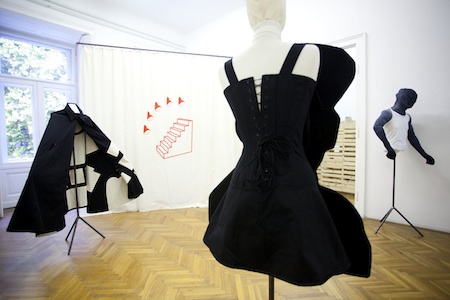Katarina Šević

Handcrafted objects often carry a certain intimacy and a sense of the slowing down of production. The irregularity, tacit knowledge, and even moral weight associated with craft, however, have also been associated with anti-progressive or conservative values – the implication of dropping out of modernity. Serbian artist Katarina Ševic´ takes pleasure in manipulating the temporal and ideological expectations of the handmade. Her handcrafted wooden objects explore socialist science fiction, while her rough DIY wearable structures and handmade costumes and props evoke at once the re-enactment enthusiast’s attention to detail and an anarchic sense of open-endedness of use and function.
Ševic´’s recent solo exhibition, ‘Raft Stage’, featured News from Nowhere (2009–ongoing), an assembly of wooden objects, most of which looked as mundane and familiar as they were ambiguous in our practical memory of them. Taking as its point of reference William Morris’s 1890 work of Utopian socialist science fiction, Ševic´’s project explores the potential of linking early socialist thought with a late-19th-century Arts & Crafts take on physical objects. The installation also featured four miniature stages, ranging in design from the classical proscenium stage to an unassuming outdoor platform and a more visionary birdhouse-like structure. Strangely familiar in form, as if belonging to a recycled or reconstructed version of the future, these sculptures had an ill-fated sense of anticipation about them: they were too small to be filled with activity, and unspectacular in their modest take on futurism. The productive tension could be found in the asymmetry of form and content: handcrafted miniatures evocative of the 19th-century bourgeois home, coupled with the future promise of their socialist Utopian underpinnings.
What appeared to be the disorientated props and costumes for these stages populated the rest of the gallery. Ševic´’s series of wearable structures, Cape, costume, Headdress, costume and Shirt, costume (all 2012) evoked at once a restless avant-gardism reminiscent of Oskar Schlemmer, mixed with something a great deal more mystical and pre-historical: a cape meets a miner’s costume, gesturing towards the impossible structure of the ‘shirt costume’ with its eight arms – we can only imagine the arrival of the performers.
Whereas most of the costumes had a certain promiscuity of use and history, the installation Gasium et Circensens / Dear Zoltan! (2011–12), made in collaboration with the artists’ group Tehnica Schweiz, maintained a certain fidelity to its narrative. Taking the form of a video documentation of an outdoor play, a wooden wearable structure and a theatre poster, the work revolved around an abandoned open-air stage at a now-closed housing estate for workers at a Budapest gas factory. It is a site marked by planned urbanism from both antiquity and modernity: built atop the excavation site of the Roman city of Aquincum, the spot was part of an exemplary model for workers’ dwellings in the 1910s and served as a Culture House from the 1950s onward. Using this rich history as material, Ševic´’s play was based on her two-year correspondence with the Historical Museum of Budapest about the building’s use since its closure in the early 1990s. The dialogue plots a complex journey of the re-adaptation of a piece of socialist architecture, as well as exposing the tight bureaucratic web surrounding its recent past. From the performed correspondence, we learn little more than the fact that the Historical Museum uses the structure as a storage unit, but nothing about what these excavated objects might be and for whom they are available. As such, the building simply stands as a new-age socialist ruin that houses antique and medieval finds.
Gasium et Circensens resonated with the row of potential stages in News from Nowhere. These are structures that both contain a certain longing for activity and a complex version of a previous, and potentially exhausted, sense of the future. It is within this state of exhaustion of symbols and methods that the stage as a space for performed actions in Ševic´’s work also gains an additional charge. There is nothing stable about a ‘Raft Stage’, and as such it is also open to the anachronistic encounter, an abstract sense of the stage as a largely unpredictable yet anticipatory structure for future activity.















